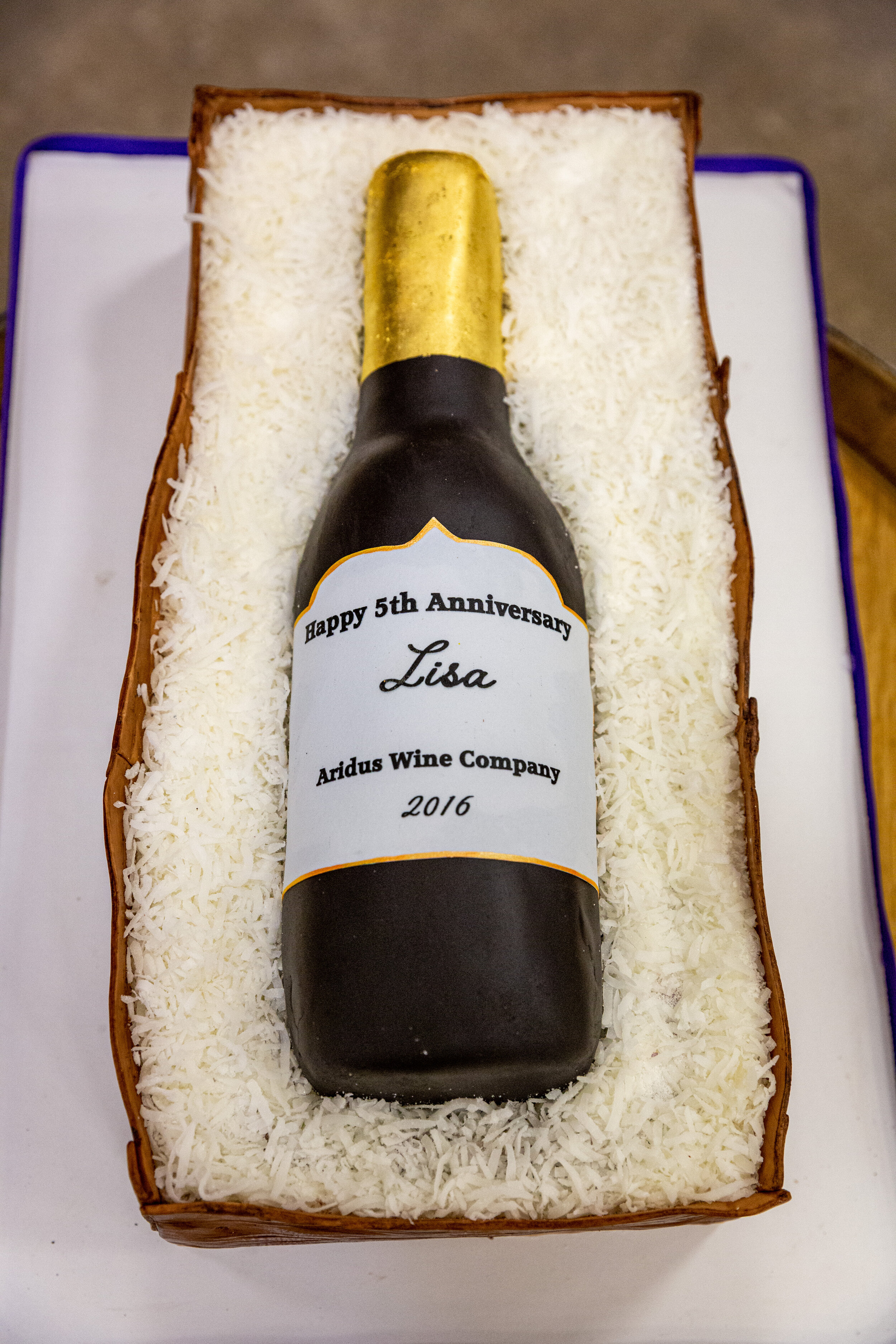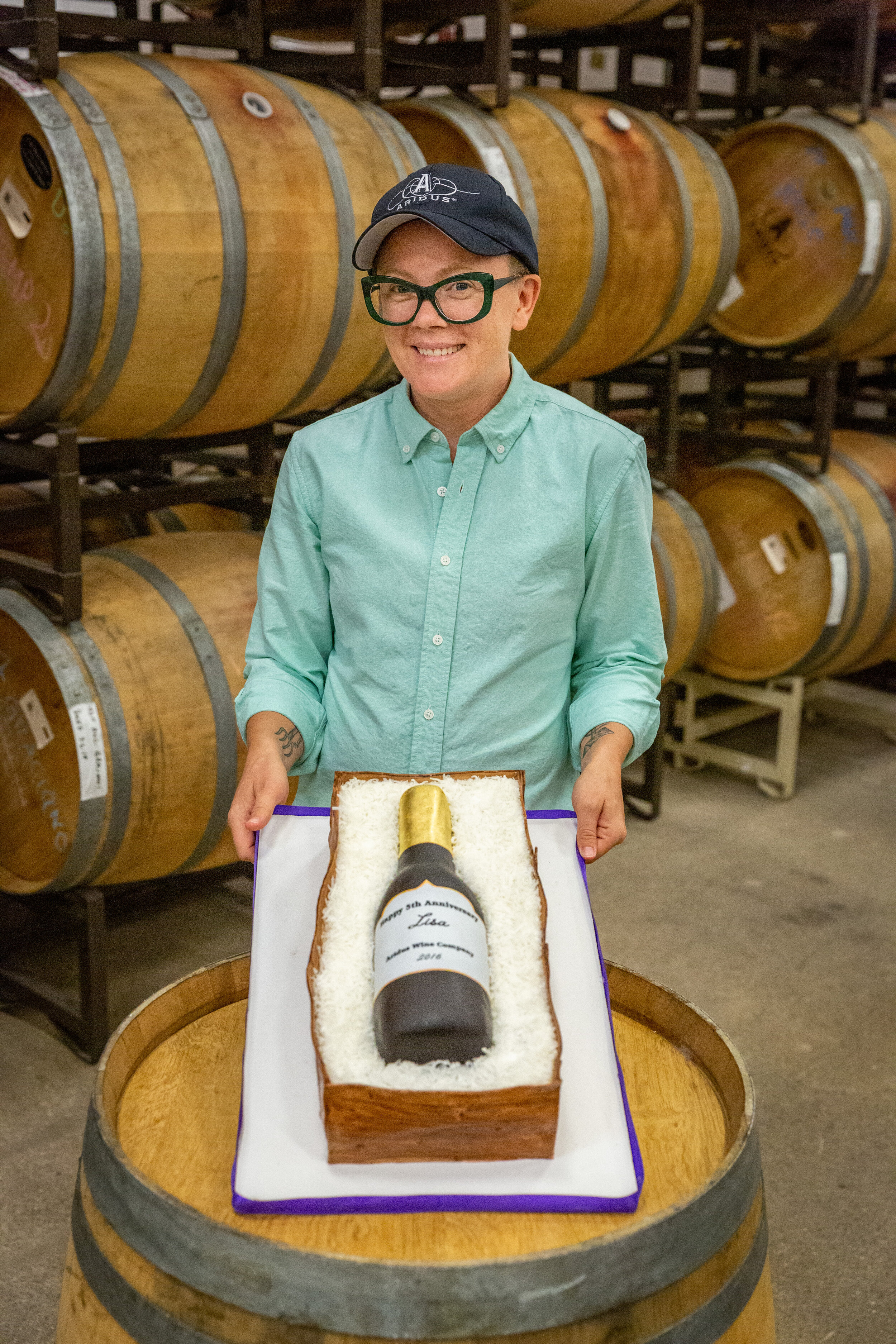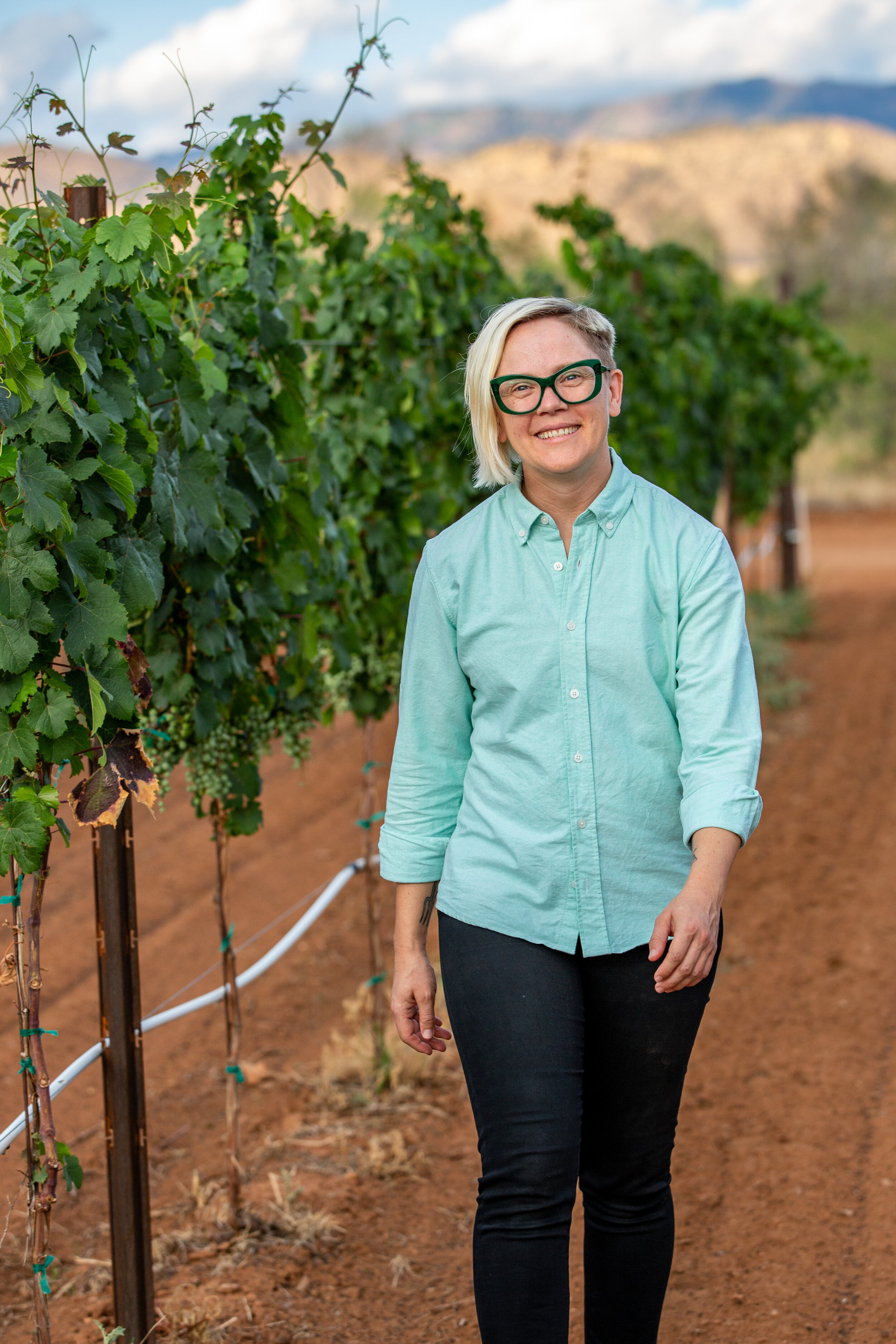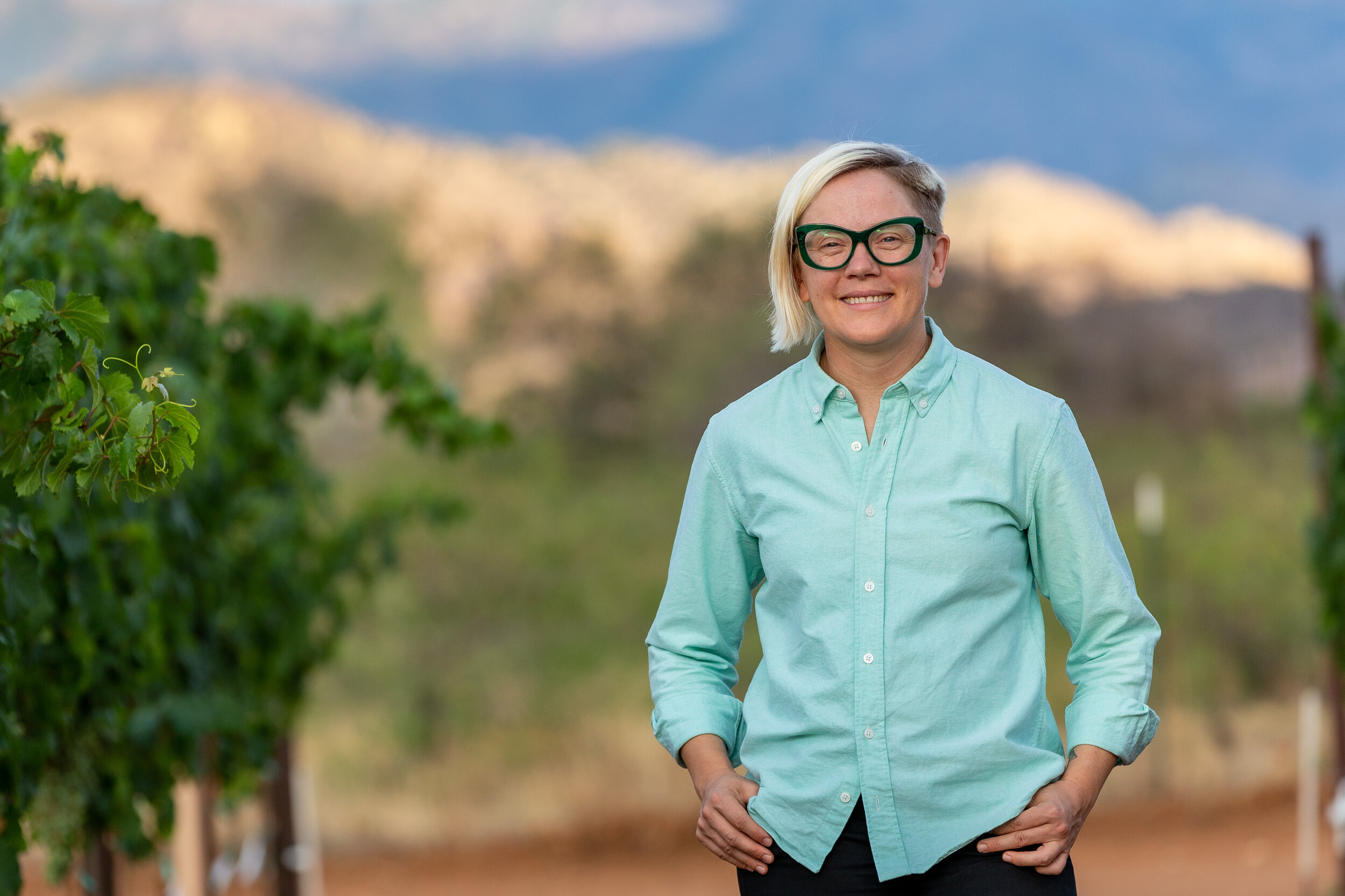Aridus Celebrates Winemaker’s 5th Anniversary
Aridus Wine Company is honoring its winemaker, Lisa Strid, on her fifth anniversary. To celebrate, she signed bottles and shared “anniversary” cake with friends and customers in the Willcox tasting room on July 8 and in the Scottsdale tasting room on July 9.
Over these years, she has made 149 wines from five different growing regions---Cochise County and Willcox (Arizona); Mimbres Valley (New Mexico) and Lodi and Central Coast (California). She directs not only the production of Aridus’ wines, but also is responsible for the winery’s custom crush operation, where growers bring their grapes from throughout Arizona, New Mexico and California. She is also closely involved with Aridus’ 40-acre estate vineyard in the Chiricahua Hills appellation outside the town of Pearce along Turkey Creek---a picturesque spot perched at 5,200 foot elevation currently planted to Malvasia Bianca, Sauvignon Blanc, Viognier, Tempranillo, Petite Verdot, Merlot, Syrah, Cabernet Franc, Cabernet Sauvignon, Graciano, Petite Sirah and Malbec.
“Five years is a lifetime in the wine business,” adds Aridus’ founder, Scott Dahmer. “Lisa’s guided us through tremendous growth and the ongoing refinement in our winemaking techniques. We’re so excited to celebrate this milestone with her,” he says.
Strid (rhymes with ‘steed’) is a Wyoming native who fell in love with wine while working alongside her uncle on his small vineyard and winery in the wilds of western Washington. After a year of pruning, netting, crushing, and fermenting Pinot Noir and Pinot Gris, she realized she wanted to make a career of the work, and entered Oregon State University to study enology and viticulture. While in school, Lisa interned at Alexana Winery in Oregon’s Dundee Hills, where she learned the ins and outs of luxury, small-lot winemaking. Upon finishing her degree, she moved to California to work for E&J Gallo, where after several years she became a research winemaker, focusing on innovative equipment use and new technology validation trials.
In reflecting on the uniqueness of working at a winery in the Southwest, she mentions the challenges during the growing season, specifically, understanding how to work through the monsoon season, which runs from mid-June to mid-September. “You never know how much rain you’re going to get,” she explains. 2020 was the driest monsoon season the Arizona desert has ever seen. In 2016, her first year at Aridus, the rain was the heaviest of the preceding decade. “It’s a critical time, while the grapes are trying to go through veraison,” she says. Monsoons are heavy rains which can last from 20 minutes to a few hours. One of the worst outcomes can be the hail which is part of the monsoon rain, which can rip off leaves and damage the fruit or even cause an entire crop to be lost. The desert setting can also see wildfires even during monsoon season.
One notable achievement in Lisa’s time at Aridus was when Aridus’ 2015 Syrah was named a “Hot Brand” by Wine Business Monthly in its February 2019 issue. The award citation noted “…it’s a chance for us to explore new regions, varietals and new winemakers. All the winemakers selected reflect the diversity that is the wine culture in the United States and all have an innate desire to produce something they, and the consumer, will love.”
Around the winery Strid is known for her huge knowledge of insects, from tarantula hawks to wasps, praying mantis, rose chafers, conchuela bugs and crab spiders. She also seeks out saguaro and prickly pear cactus flowers. “Cactus flowers are some of the most vibrant, beautiful, and ephemeral flowers - there’s nothing like desert blooms,” she says. In her career prior to Aridus she never saw rattlesnakes, owls, roadrunners, hawks and javelinas on the crush pad.
Were there varieties she had never made before she came to Aridus? Yes: “I loved the challenge of making Graciano, Lemberger, Dornfelder, Dolcetto and Aglianico,” she explains.
What are Lisa’s favorites of the winery’s current releases? “If I had to choose, those would be the Sauvignon Blanc, Cabernet Franc, Graciano and Syrah. I enjoy making Sauvignon Blanc because it’s the first fruit into the winery and it means I can really pay it close attention. The Syrah is our first red into the winery so it’s exciting as the shift into making reds. The Cabernet Franc is the last red in, so once we’re done making it, it’s time to celebrate all the hard work we’ve put in over the harvest. The Graciano is my favorite red from Arizona - one of those magical surprises in that it is so unique, grows so well, and tastes fantastic,” she explains.
When she’s not at the winery, among other hobbies Lisa enjoys cooking. When not making a lemon tart, she’s been fine-tuning her quiche skills: she’s sharing a recipe for a favorite one, which she’s found to be a great match with the Mourvèdre (“It picks up the hint of nutmeg nicely,” she explains).
________________________________________________________________________
Lisa Strid’s Cabbage & Impossible Meat Quiche
Make the tart dough (recipe below). Once the crust comes out of the oven, while it’s still hot, I sprinkle 1/3 to 1/2 cup of the grated cheese onto it.
1 yellow onion
8 cloves of garlic
¼ head cabbage
Olive oil
Salt
Pepper
Nutmeg
Red wine vinegar, optional
6 ounces Impossible Meat
5 eggs, room temperature
1/3 cup whole milk
1 cup grated cheese (can be your own choice of types, I often combine cheddar, manchego, and Gruyere)
I chop the onion and garlic and thinly slice the cabbage. Sauté the onions and garlic in olive oil with a little bit of salt. Once the onions are translucent, add the cabbage and sauté until the cabbage starts to brown, stirring periodically. You can add a bit of red wine vinegar to the pan if anything starts sticking, or just for some additional flavor. Once that mixture looks cooked through, I add the Impossible Meat and season with pepper, a dash of nutmeg, and some additional salt. Once the meat is browned, I fill the tart crust with the whole shebang.
While things are sautéing, I crack the eggs into a small bowl, and whisk with the milk until it’s well homogenized and a bit frothy.
Once the filling is in the crust, I add the egg mixture. Usually it looks like there’s no room and the thing is going to overflow, but so far it has all fit just fine.
Next sprinkle the remaining cheese over the top. Place the pan on a larger cookie sheet or baking dish. Cover the quiche with foil and bake at 350º for 45 minutes. Remove the foil and bake uncovered for another 15-20 minutes.
Let cool for at least 15 minutes. Can be served hot, warm or room temperature or even cold (if you have any leftovers!).
French Pastry Dough, adapted from David Lebovitz
Makes one 9-inch tart shell
1 tablespoon vegetable or canola oil
3 ounces unsalted butter, cut into pieces
3 tablespoons water
1 tablespoon sugar
1/8 teaspoon salt
1 rounded cup all-purpose flour
Preheat the oven to 410º F .
1. In a medium-sized ovenproof bowl, such as a Pyrex bowl, combine the butter, oil, water, sugar, and salt.
2. Place the bowl in the oven until the butter is bubbling and starts to brown just around the edges. Check often; it may take up to 15 minutes.
3. When done, remove the bowl from oven (and be careful, since the bowl will be hot and the mixture might sputter a bit), dump in the flour and stir it in quickly, until it comes together and forms a ball which pulls away from the sides of the bowl.
4. Transfer the dough to a 9-inch tart mold with a removable bottom and spread it out with a spatula.
5. Once the dough is cool enough to handle, pat it into the shell with the heel of your hand, and use your fingers to press it up the sides of the tart mold. Reserve a small piece of dough, about the size of a raspberry, for patching any cracks.
6. Prick the dough all over with the tines of a fork about ten times, then bake the tart shell in the oven for 15 minutes, or until the dough is golden brown.
7. Remove from the oven and if there are any sizable cracks, use the bits of reserved dough to fill in and patch them.
I find it best to pinch off a small amount of the reserved dough, roll it gently between your fingers to soften it, then wedge it into the cracks, smoothing it gently with your pinky.
8. Let the shell cool before filling.




